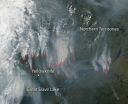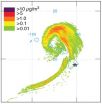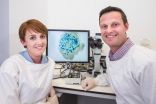(Press-News.org) Achalasia is a rare disease – it affects 1 in 100,000 people – characterized by a loss of nerve cells in the esophageal wall. While its cause remains unknown, a new study by a team of researchers at KU Leuven in Belgium, the University of Bonn in Germany and other European institutions confirms for the first time that achalasia is autoimmune in origin. The study, published on 6 July in Nature Genetics, is an important step towards unraveling the mysterious disease.
When we swallow, a sphincter in the lower esophagus opens, allowing food to enter the stomach. Nerve cells in the esophageal wall control the opening and closing of this sphincter, but in people with achalasia, these nerve cells gradually disappear. Without these cells, the esophageal sphincter fails to relax, causing food to accumulate in the esophagus. This results in swallowing problems, regurgitation, vomiting, nighttime coughing, chest pain and weight loss.
Because so little is known about achalasia, current treatments are limited to stretching the esophageal sphincter endoscopically with a balloon or surgically cutting the sphincter. But while these treatments can help alleviate the disease's symptoms, they do not address its cause.
Researchers have long suspected that an autoimmune response lies at the root of the disease, but an explanation for why the immune system of people with achalasia responds as it does remains elusive.
One possible explanation is that esophageal nerve cells are targeted by the body's defenses due to a miscued immune response to an earlier viral infection – the immune system mistakes the nerve cells for the virus and attacks them.
Based on their results, the researchers in this study now think that genetics may play a more important role than previously thought in determining who is at risk for achalasia. Because the disease is so rare, cohorts in previous genetic studies have been too small (less than 300 patients) to draw significant conclusions.
Together with German colleagues, researchers at KU Leuven studied the DNA of 1,506 achalasia patients and 5,832 healthy volunteers from Central and Southern Europe. The study is the first systematic, genome-wide association study on achalasia and involves the largest cohort ever analyzed for the disease.
The researchers genotyped 196,524 tiny differences – called single-nucleotide polymorphisms, or SNPs, pronounced 'snips' – in the immune-related DNA of people with achalasia, and compared the results with the DNA of the healthy volunteers. 33 SNPs were found to be associated with achalasia.
Surprisingly, all 33 were located in the so-called 'major histocompatibility complex' (MHC) region of chromosome 6, the most gene-dense region in the human genome. This region is also known to be associated with other autoimmune disorders, including multiple sclerosis, type 1 diabetes and lupus. This evidence was enough for the researchers to confirm that achalasia is itself an autoimmune disease.
The researchers also pinpointed a specific string of amino acids inserted in the DNA of people with achalasia but not in the controls. The string, 8-amino acids long, is located in the cytoplasmic tail of HLA DQβ1. Moving forward, the researchers will examine the functional effects of these extra amino acids – in the hope of finding the cause, and eventually the cure, of this enigmatic disease.
INFORMATION:
Mysterious esophagus disease is autoimmune after all
Study is first to confirm achalasia as an autoimmune disease and pinpoint its genetics
2014-07-29
ELSE PRESS RELEASES FROM THIS DATE:
Worldwide water shortage by 2040
2014-07-29
Two new reports that focus on the global electricity water nexus have just been published. Three years of research show that by the year 2040 there will not be enough water in the world to quench the thirst of the world population and keep the current energy and power solutions going if we continue doing what we are doing today. It is a clash of competing necessities, between drinking water and energy demand. Behind the research is a group of researchers from Aarhus University in Denmark, Vermont Law School and CNA Corporation in the US.
In most countries, electricity ...
Mortality rates increase due to extreme heat and cold
2014-07-29
Epidemiological studies have repeatedly shown that death rates rise in association with extremely hot weather. The heat wave in Western Europe in the summer of 2003, for example, resulted in about 22,000 extra deaths. A team of researchers led by Dr. Alex-andra Schneider at the Institute of Epidemiology II at the Helmholtz Zentrum München examined the impact of extreme temperatures on the number of deaths caused by cardiovascular disease in three Bavarian cities and included both high and low temperatures in the study.
"Our findings confirm the results of our previous ...
A new brain-based marker of stress susceptibility
2014-07-29
DURHAM, N.C. -- Some people can handle stressful situations better than others, and it's not all in their genes: Even identical twins show differences in how they respond.
Researchers have identified a specific electrical pattern in the brains of genetically identical mice that predicts how well individual animals will fare in stressful situations.
The findings, published July 29 in Nature Communications, may eventually help researchers prevent potential consequences of chronic stress -- such as post-traumatic stress disorder, depression and other psychiatric disorders ...
First grade reading suffers in segregated schools
2014-07-29
A groundbreaking study from the Frank Porter Graham Child Development Institute (FPG) has found that African-American students in first grade experience smaller gains in reading when they attend segregated schools—but the students' backgrounds likely are not the cause of the differences.
According to the Center for Civil Rights, although the United States is becoming more racially and ethnically diverse, segregation is still on the rise. To better understand segregation's impact on student performance, FPG scientists looked at nearly 4000 first graders in public schools ...
Local education politics 'far from dead'
2014-07-29
EAST LANSING, Mich. --- Teach for America, known for recruiting teachers, is also setting its sights on capturing school board seats across the nation. Surprisingly, however, political candidates from the program aren't just pushing its national education agenda, they're advancing local issues as well, according to a new study.
The findings, said Michigan State University's Rebecca Jacobsen, refute the argument that school boards have become ineffective and obsolete in the wake of national education reform. Teach for America, a nonprofit that enlists high-achieving college ...
Wildfires continue near Yellowknife, Canada
2014-07-29
The wildfires that have been plaguing the Northern Territories in Canada and have sent smoke drifting down to the Great Lakes in the U.S. continue on. NASA's Aqua satellite collected this natural-color image with the Moderate Resolution Imaging Spectroradiometer, MODIS, instrument on July 26, 2014. Actively burning areas, detected by MODIS's thermal bands, are outlined in red. Copious amount of smoke are drifting northward in this image. Smoke is also creating havoc for residents of Yellowknife. Fire has caused power outages in the area and because of the smoke, line ...
Stem cell advance may increase efficiency of tissue regeneration
2014-07-29
A new stem-cell discovery might one day lead to a more streamlined process for obtaining stem cells, which in turn could be used in the development of replacement tissue for failing body parts, according to UC San Francisco scientists who reported the findings in the current edition of Cell.
The work builds on a strategy that involves reprogramming adult cells back to an embryonic state in which they again have the potential to become any type of cell.
The efficiency of this process may soon increase thanks to the scientists' identification of biochemical pathways ...
New research reveals Pele is powerful, even in the sky
2014-07-29
One might assume that a tropical storm moving through volcanic smog (vog) would sweep up the tainted air and march on, unchanged. However, a recent study from atmospheric scientists at the University of Hawai'i – Mānoa (UHM) revealed that, though microscopic, gasses and particles from Kilauea volcano exerted an influence on Tropical Storm Flossie – affecting the formation of thunderstorms and lightning in the sizeable storm.
In July 2013, as Flossie approached the Hawaiian Islands, satellites steadily monitored lightning, rainfall, cloud cover, temperature and ...
Herpes remains active even when no symptoms appear
2014-07-29
Scientists investigating the herpes virus have been surprised to find an ongoing conflict in the cells of sufferers, even when the virus is apparently dormant.
Herpes Simplex Type 1 is a virus that causes cold sores. It remains in the body's nervous system indefinitely after infection. Around 80 per cent of Australians carry the virus, although it is usually in a dormant state.
"We thought when the disease was dormant, it was a truce," said Associate Professor David Tscharke from The Australian National University Research School of Biology. "It turns out that the virus ...
How does microRNA-124 promote the neuronal differentiation of BMSCs?
2014-07-29
MicroRNAs (miRNAs) play an important regulatory role in the self-renewal and differentiation of stem cells. Dr. Defeng Zou and co-workers from the First Affiliated Hospital of China Medical University, China focuses on the effect of miRNA overexpression on the differentiation of bone marrow-derived mesenchymal stem cells into neurons. In the study released on the Neural Regeneration Research (Vol. 9, No. 12, 2014), researchers used GeneChip technology to analyze the expression of miRNAs in bone marrow-derived mesenchymal stem cells, neural stem cells and neurons. They constructed ...
LAST 30 PRESS RELEASES:
Scalable and healable gradient textiles for multi‑scenario radiative cooling via bicomponent blow spinning
Research shows informed traders never let a good climate crisis go to waste
Intelligent XGBoost framework enhances asphalt pavement skid resistance assessment
Dual-function biomaterials for postoperative osteosarcoma: Tumor suppression and bone regeneration
New framework reveals where transport emissions concentrate in Singapore
NTP-enhanced lattice oxygen activation in Ce-Co catalysts for low-temperature soot combustion
Synergistic interface engineering in Cu-Zn-Ce catalysts for efficient CO2 hydrogenation to methanol
COVID-19 leaves a lasting mark on the human brain
Scientists use ultrasound to soften and treat cancer tumors without damaging healthy tissue
Community swimming program for Black youth boosts skills, sense of belonging, study finds
Specific depressive symptoms in midlife linked to increased dementia risk
An ‘illuminating’ design sheds light on cholesterol
Who is more likely to get long COVID?
Study showcases resilience and rapid growth of “living rocks”
Naval Research Lab diver earns Office of Naval Research 2025 Sailor of the Year
New Mayo-led study establishes practical definition for rapidly progressive dementia
Fossil fuel industry’s “climate false solutions” reinforce its power and aggravate environmental injustice
Researchers reveal bias in a widely used measure of algorithm performance
Alcohol causes cancer. A study from IOCB Prague confirms damage to DNA and shows how cells defend against it
Hidden viruses in wastewater treatment may shape public health risks, study finds
Unlock the power of nature: how biomass can transform climate mitigation
Biochar reshapes hidden soil microbes that capture carbon dioxide in farmland
Reducing saturated fat intake shows mortality benefit, but only in high-risk individuals
Manta rays create mobile ecosystems, study finds
Study: Mixed results in using lipoic acid to treat progressive multiple sclerosis
Norbert Holtkamp appointed director of Fermi National Accelerator Laboratory
New agentic AI platform accelerates advanced optics design
Biologists discover neurons use physical signals — not electricity — to stabilize communication
Researchers discover that a hormone can access the brain by hitchhiking
University of Oklahoma researcher awarded funding to pursue AI-powered material design
[Press-News.org] Mysterious esophagus disease is autoimmune after allStudy is first to confirm achalasia as an autoimmune disease and pinpoint its genetics



